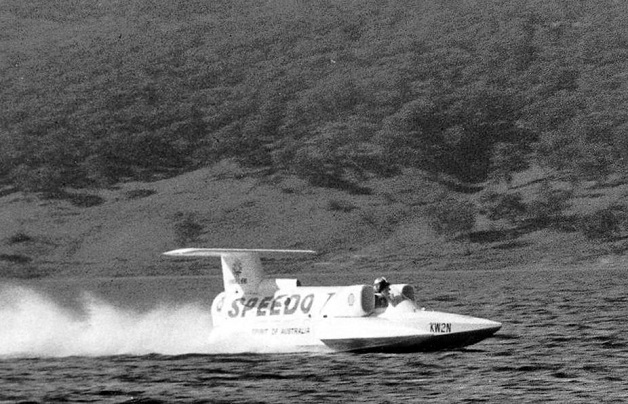
The charred, bare hills on the western foreshore of Blowering Dam following the Black Summer bushfires. Photo: Forestry Corporation of NSW.
Blowering Dam is usually the summer playground in southern NSW where lovers of watersport gather, but sadly it won’t be as accessible this summer compared to previous years.
Just 13km upstream from Tumut and three times the size of Sydney Harbour, this recreational wonderland has lured thousands of visitors who have camped, tramped, fished and splashed around those waters for around 52 years.
It’s the place where, in 1978, Ken Wharby achieved the world water speed record onboard the Spirit of Australia – 511km/h over a one kilometre stretch. This record still stands, despite the efforts of his son, David, trying to break the record in November 2020.

Ken Wharby on the Spirit of Australia after he set a new world water speed record in 1978. The record of 511km/h still stands. Photo: Wharby Motorsport.
But access to the dam’s more secluded western foreshore – a popular spot with campers – will remain closed during the Christmas period due to damaged roads and the high risk of tree falls as a result of the past summer’s bushfires.
What lies behind this news is the effort being made, the frustration experienced and the historic decision that actually preserved the future of the dam for public and utility use.
Forestry Corporation of NSW’s Snowy Region manager, Dean Anderson, said rain and road damage has severely limited remediation work around Blowering Dam during the past 10 months.
“The scale of infrastructure damage is simply unprecedented,” he said. “We have not been able to access some roads ourselves due to hazardous conditions.”
Around 170km of damaged roads are still in need of repair – and that’s just in the state forest next to Blowering Dam.

Ken Wharby reaching 511km/h on Blowering Dam. Photo: Wharby Motorsport.
“This is longer than the road trip from Tumut to Gunning,” said Mr Anderson.
With the post-bushfire tab already at $1.3 million and ongoing work set to continue well into 2021, it’s not just about the roads.
The main body of water is surrounded by 60 additional dams, tasked with the job of protecting the catchment.
This dates back to the 1960s, says Mr Anderson, when the then Forestry Commission of NSW was asked to establish pine plantations to help protect the Blowering catchment.
“The smaller dams were built to reduce silt and soil entering the dam,” he said. “They certainly did a good job of that when silt and ash washed down the bare hills in the aftermath of the bushfires.”
He said remediating the network of silt dams is a priority, with engineers and soil specialists engaged to assess what should be done with each individual dam.
“One dam has been emptied using a local contractor as a way of evaluating what options are available,” said Mr Anderson.
In the interim, aerial sowing of annual pasture grasses has provided initial groundcover until the dead trees can be removed and a new pine plantation re-established.
The following roads will remain closed during summer:
- Yellowin Access Road.
- McDonalds Trail.
- Sturgess Trail.
- Foreshore Road, from Jounama Dam to Snubba Road.
- Blowering Camp Road.







